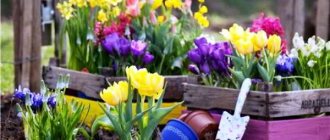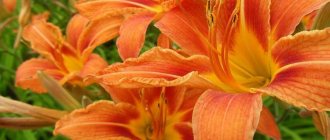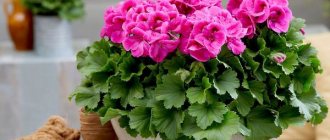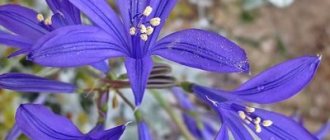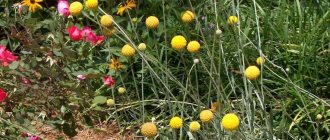Despite the fact that the bell has about four hundred and forty species, there are also some flowers that, from a distance, may be similar in structure to the bell. We have prepared for you a detailed selection of bell-like flowers with photos and basic recommendations for care and propagation. Use, save, share with other gardeners!
Adenophora
Adenophora is a close relative of the bell, which is easy to guess from its popular name - bell.
Using hedgehogs to process potatoes
Types of seedling cassettes and their use
Hazelnut - how it grows and blooms, growing a nut in the garden
This herbaceous perennial is unpretentious, can grow in both sun and partial shade, is undemanding to the type of soil, and does not require shelter for the winter. Keep in mind that adenophora needs good soil drainage and does not grow well in acidic soils.
Bellflower blooms most of the summer. Easily propagated by seeds. In this case, winter sowing is preferable. If you did not have time to sow bells in late autumn and plan to sow in the spring, it is advisable to stratify them for a month (keep them in the refrigerator).
Seedling care
After covering with film, the box with seedlings is placed in a warm and sunny place with a temperature of at least +18°C. The first shoots will appear within 15-20 days. As soon as 75% of the crop has sprouted, the film must be removed. Bells are distinguished by a kind of “discipline”: usually this happens on the second day after the first shoots appear.
It is necessary to keep a box with germinating seedlings on the south window of the house, providing the young plants with diffused sunlight. If diffusers are not available, partial shading can be used with curtains, tulle or other plants. It should be remembered that both adult bells and their seedlings do not like direct sunlight.
Watering must be carried out as the top layer of the substrate dries. In order not to wash the plants out of the soil, you need to use a watering can with a very thin spout, almost like an oil can, or water the plants using the same spray bottle. However, it is advisable to do this procedure either in the evening or on a cloudy day.
Under no circumstances should young seedlings be exposed to drafts. Adult bells or seedlings outdoors are not afraid of winds, however, the contrast in indoor temperatures can destroy young seedlings.
Approximately 20 days after germination, the plants have a sufficient number of leaves and can be picked. Picking is done in any container. You can use an individual one, but many people prefer to use larger boxes. Typically, picking is done with a step of about 10 cm between seedlings.
Picking seedlings into individual pots
Aquilegia
Behind the beautiful name aquilegia lies a well-known watershed. He is an eagle, doves, boots - there are countless popular names. English-speaking gardeners even call it "granny's hat."
About a hundred species of aquilegia are known, but hybrids are usually grown in gardens. Almost all watersheds feel great in the middle zone and even winter in the taiga zone without shelter. In addition, they prefer partial shade. Why isn't it an ideal plant for the garden?
The height of the plant can vary depending on the species: for example, from 30-40 cm for Biedermeier aquilegia and up to 120 cm for McCann hybrids.
Aquilegia blooms between June and August, depending on the variety. Sowing is carried out in open ground in the fall or through seedlings in March-April or in open ground in May.
Diseases and pests
Bells are resistant to diseases and pests. However, with prolonged cultivation in one place, they can develop fusarium, sclerotinia, and botrythiosis. For prevention and treatment, plants and the soil around them are treated with a solution of foundationazole in spring and autumn.
Pests of bells are pennies and slugs (for low-growing species). Superphosphate, shag, or special granules scattered around plants save you from slugs. For pennitsa - spraying with a decoction of capsicum, garlic or the same shag.
Brugmansia
This plant is often called "angel's trumpets". This is due to the fact that it grows incredibly quickly, and the flowers of this crop can increase by 3-4 cm in 24 hours, and if the growing conditions are more than favorable, then even by 6-7 cm.
Brugmansia is a large and lushly flowering tree-like shrub that reaches 5 m in height. Its flowers are incredibly attractive. These are huge bells, up to 20 cm in diameter and up to 50 cm in length.
The buds of the culture have a persistent characteristic aroma, which is especially intensified at night. The color of the petals can be pink, orange, peach, yellow, cream and even greenish.
Hyacinthoides
Hyacinthoides are bulbous perennials that belong to the early flowering plants. There are other names: “Spanish scilla”, “Spanish endymion”, “Spanish scilla” and “wild hyacinth”.
This is an unpretentious crop that can often be found in flower beds and garden plots. The plant has basal leaves 20-30 cm long and a single peduncle reaching a height of up to 30 cm.
Hyacinth may have lilac, white, pink, blue or blue bell-shaped flowers 1.5-2 cm in diameter. The crop blooms at the end of May or beginning of June, and this period lasts up to 20 days.
Gentian
Gentian has not yet taken root among our gardeners as a popular flowerbed decoration. It is quite rare to find it in a modern front garden. However, this plant is undeservedly underrated. This is a low to medium-height herbaceous plant with large flowers located very close to each other, thus creating a blooming cloud. The gentian plant came to us from the wild. It is great for decorating flower beds, edging flower arrangements, and also for decorating borders. This flower has collected the widest palette of blue shades. No other plant can boast such an abundance of blue, blue and purple flowers. There are about 90 varieties of gentian, among which there are other shades, for example, white, pink and yellow. Gentian has a long flowering period, which begins in summer and ends in late autumn. It is quite common in different latitudes of Europe and Asia.
How to water Decembrist at home?
How to replant aloe at home step by step
How to replant anthurium at home video
A plant such as gentian is propagated by dividing the bush, cuttings or sowing seeds. Planting and caring for seedlings require attention. Growing gentian from seeds is difficult because the seeds are very small and their development requires moist, well-ventilated conditions with a temperature of 7 degrees Celsius. They germinate only after 1-3 months. If the temperature rises significantly during this period, the seedlings may die.
Bell flower: botanical description, features of care and reproduction
Bluebells (Campanula) are a large group of flowers with over 300 species of annual, biennial and perennial plants that come in a variety of sizes and colors. The main characteristic is the inverted, open cupped flowers in shades of pink and white, lavender or light blue.
Good to know! The plant is a climber and will grow throughout the season, trying to cover all available soil. Most bluebells begin to bloom in July and continue to produce new buds until the first frost (usually October). Other plant names: Creeping bellflower, Rampion Bellflower, European bellflower. Eurasia is considered the homeland.
Botanical description
The flowers, in the form of a small tassel, are located along one side of the stem at the top of the plant. Some species may have a flower calyx up to 2.5-3 cm long, which are attached to the stem with a thin tail and move easily under the influence of the wind, very much reminiscent of the bell-shaped flower, which is where they got their name.
The bud has 5 pointed petals, with sparse hair (fluffy) cover. Inside the bell are 5 curly yellow stamens and a convex pistil with a divided, curled tip.
The color of the bud can be very diverse: from soft blue, dark blue and bright purple.
The bracts at the base of the flower have 5 narrow, pointed petals that bend away from the flower and resemble a small cap.
The leaves are quite thin, but have a very rough texture and jagged edges, usually in the shape of a heart, becoming smaller and proportionately tapering as the stem rises.
The lowest leaves are 15 cm in size, the middle ones up to 10 cm, the top ones up to 5 cm. The leaves in the upper part of the plant have almost no stem.
The stem itself is also quite coarse with stiff hairs, purple in color, especially at the base of the bell. It grows mostly straight, almost without bending.
Important! Bluebells, especially European varieties, are very popular in gardening, as they do not require special care, can be sown independently over large areas and have a fairly strong root system, “clogging” any weeds.
But the bell has one significant drawback - if you do not control its growth, it will be quite problematic to remove it, since every root that remains in the ground will give rise to a new shoot next spring, so you often have to resort to herbicides.
There is a fairly wide variety of plants, the flowers of which are not only bells, but also come in the form of small trumpets, and some species also have star-shaped flowers.
Rare specimens, in addition to blue, blue and violet, are completely white and even red. Most of the species diversity spreads along the ground, but there are also vertical flowers.
As a rule, the bell is a perennial plant, only rare varieties live from 1 to 2 years.
Bells are very hardy plants, most species grow in temperate latitudes , but there are also many specimens from the northern regions and even polar species that, like snowdrops, emerge from under the snow cover for 1-2 warm months. Flowering begins from early spring to mid-summer (depending on the species), but the peak occurs in July and lasts until late autumn.
Loading …
Reproduction of bluebells
Campanula propagation occurs mainly by seeds. Since most of them are perennial species, the plant self-seeds. The same applies to two-year-old varieties.
Only annual plants require additional care; you will have to collect the seeds yourself and plant them the next year. In addition to seeds, bells can also be propagated by seedlings (i.e.
buy already sprouted flowers from nurseries) and dividing the rhizomes.
Bellflower propagation by seeds
Growing bluebells from seeds is very easy. The only nuance that should be taken into account is that seeds are planted 8-10 weeks before the onset of spring. Since the seeds are so small, they barely need to be covered with soil, meaning they do not need to be buried in the pot.
Simply sprinkle them into an appropriate container or special tray for growing seeds filled with moist peat or universal soil, water generously and place in a warm place (at least 20-22 degrees Celsius) where the tray will receive direct sunlight.
Remember to keep the soil moist at all times.
Another way to propagate white bell seeds is to sow the required area directly on the site.
But this can be done only on the condition that frosts on the soil are no longer expected, and the snow has completely disappeared from the ground.
In this case, the seeds will need to be sprinkled with a little soil to prevent them from being blown away by the wind. Within 2-3 weeks the first bell sprouts should appear.
Bellflower propagation by division
You can also propagate bluebells by dividing the roots. This is usually done in the spring when new growth appears. Dig up the rhizome along with a ball of earth (at least 15-20 cm). Then carefully shake off the soil so as not to damage the roots.
Separate them in a way convenient for you: with your hands, a knife, garden shears, etc. Depending on the volume of the root, one bush can be divided into 2-4 new plants.
To plant, use a hole of the same depth as the donor plant; after digging, be sure to water the soil thoroughly.
Planting bellflower seedlings in the ground
Once the seedlings are about 8-10cm tall, you can start transplanting the bluebell seedlings into the garden or into large, individual pots. Before planting in pots, make sure the soil is well fluffed up and drains excess moisture.
When planting, make a hole in the soil wide enough to accommodate the seedlings, but not too deep, as the top of the roots should remain almost at ground level. Water all seedlings generously.
Important! Seedlings planted in the ground for the first time will not bloom during the first year of growth, so there is no need to worry that something has happened to the plant.
Most bluebells produce good color if planted (or potted) in sunny areas with no more than 2-3 hours of shade per day.
The plant grows vigorously in moist, well-drained soil with a high content of organic matter.
Since most bluebells are climbing plants, in open areas it is necessary to plant them at a small distance from each other (up to 2 m) so that they have some room to wander.
Planting a bell from the nursery
Container plants from the nursery can be safely planted in outdoor areas at any time during the growing season. This is especially true for rare species, for example, Campanula punctata Lam , a dotted bell, planting and caring for which requires special conditions.
Prepare the bed in advance using a garden fork or tiller to loosen the soil to a depth of 30 to 40 cm. Then add 8-10 cm of compost and mix with the fluffed soil. Water a little.
Dig a hole twice the diameter of the pot containing the plant. Carefully remove the bellflower from the container and place it in the hole so that the top of the root ball is level with the surface of the soil.
Gently trample the soil around the rhizome with your hands and water thoroughly.
Features of care
Planting and caring for bluebells is not particularly difficult, but if you want a garden full of colorful flowers, there are a few basic plant care tips you can follow.
General Tips
Note! Each spring, add a small amount of organic fertilizer to the soil, as well as a thin layer (up to 3 cm) of compost, then apply a 3-5 cm layer of mulch on top to retain moisture and control weeds.
To prevent self-seeding, gradually remove spent flowers. In autumn, you can safely cut off all the buds right down to the stem, even if they are still blooming.
For low-growing varieties, it is not recommended to cut off all the buds, especially below the middle of the stem. You can completely mow down the bell (without removing the roots) every 3-5 years.
This will provoke new, abundant growth (typical only for perennial varieties).
Irrigation
Actively water the plants in the summer, if the monthly precipitation does not exceed 3-5 cm. The bluebell should be watered in the early morning. First, pour a small amount of liquid under the stem and watch how the water is absorbed.
If the absorption process lasts from 10 to 20 minutes, water is present throughout the entire depth of the roots; additional watering is not required.
Keep the soil under the bells moist at all times, but do not overdo it, as too much water can cause root rot to develop.
When a plant does not have enough water, you will immediately notice it by the number of flowers.
This is especially clearly visible in the terry bellflower variety: during a period of drought, there is an active delay in flowering, while the ovary will appear, but there will clearly be fewer open buds.
During periods of drought, it is necessary to allow the soil to dry out at least 5 cm and only then water again after a few days.
Insects and diseases
Aphids, thrips, whiteflies and fungus gnats are the most common natural enemies of bluebells. The greatest danger is posed by aphids, which in the shortest possible time will destroy all the young shoots of the plant, and after that they will attack the tougher leaves.
Inspect plants for common pests such as snails and slugs. If found, remove them by picking them up with your hands to prevent damage to leaves and trunks.
To prevent snails from climbing onto the bush itself, water the plant at the root, and not with a watering can on top of the foliage, as snails and slugs constantly strive for the wet surfaces of plants.
The pink perennial bluebell is especially susceptible to snails.
Important! The mold Botrytis and the Myrothecium fungus from the order Hypocreales are the most common diseases affecting bluebells.
If you find powdery mildew on the leaves, remove all damaged parts of the plant and thin out healthy bushes to increase air concentration. If necessary, completely remove all the seedlings at the root; the plant will grow back next season.
As a preventive measure against insects and fungus, it is necessary to periodically spray the plants approximately once a month, and if fungus is detected, then every 10-12 days with special chemical compounds. The simplest method of prevention is horticultural oil.
Types of bells
Bluebells are divided into two categories: tall or vertical, which are ideal for planting along the facade of a building or the borders of a path; and low ones that spread well along the ground, creating beautiful flower beds.
Peach bell
Campanula persicifolia is one of the most popular varieties of bluebell , characterized by wide, bell-shaped flowers in shades of blue, pink, white and purple. It begins to bloom in early summer.
Canterbury bells
Biennial Canterbury bells (C. medium) are a selectively bred variety that can reach 60-70 cm in height. It has characteristic, almost square, bell-shaped flowers in lilac, blue, pink and white shades. They begin to bloom the next year after planting.
Bluebell Birch hybrid
This attractive dwarf breeding species is ideal for forming rock gardens and country flower beds . It climbs well, making it suitable for decorating small borders and curbstones.
The low-growing, bell-shaped flowers are characterized by an attractive, poisonous purple hue with hints of blue around the edges.
The height of such bells does not exceed 15 cm, but one bush can reach 15-20 cm in width.
Bell Viking
Known for its straight stems, this bell-shaped flower is a favorite plant of hummingbirds. It blooms with small purple buds and requires virtually no constant care. It has no natural enemies, so it is very popular among gardeners.
Adriatic bluebell
Campanula garganica is unlike other species due to its characteristic foliage, so dense that from the outside the plant resembles a ball or club, the entire surface of which is dotted with bright lilac small flowers, similar to a thin blanket. Among the disadvantages, it is worth noting that the stems of the Adriatic bell are very fragile.
Korean bell
The Korean species is known throughout the world for the fact that it begins to bloom from early summer until autumn. The buds have a specific pale purple-pink hue with dark spots inside the flower. The leaves of the plant are characterized by a bright green color, which only enhances the beauty of the bush. This species can grow in the shade.
Bluebell
One of the subspecies of the group of forest bells. The very delicate but attractive flowers hang freely due to their weak stems, but it is this appearance that has made them popular. With a slight wind, the buds sway easily in the wind.
Source: https://sadim.guru/kolokolchik-cvetok-botanicheskoe-opisanie-osobennosti-uhoda-i-razmnozhenija/
Datura
Datura common (photo below) is difficult to confuse with other plants. He is big, even huge. The bush can grow up to a meter in height. The leaves are beautifully cut. They look powerful, fresh, attractive (for those who eat grass). Only animals will not feast on them. They are repelled by a strange, even disgusting smell. Datura plant can be found in large quantities in any area. Typically, Datura chooses the following areas for its habitat: wastelands, roadsides and vegetable gardens. Datura grass flowers are so magnificent that this plant has attracted the attention of landscape designers. It can be seen in flower beds and lawns. The plant is used as an ornamental. Moreover, it has a fairly long flowering period: almost all summer (depending on climatic conditions) it delights viewers with huge bowls of white flowers. You just need to keep in mind that the plant is poisonous. Flowers can be intoxicating (hence the name) with just their scent. In hot weather, in the absence of wind, it concentrates around the plant. It is not advisable to plant such “decor” in the area near children’s playgrounds, institutions, cafes, and so on. Kids may not realize that they should run away from a cloying aroma. The result is a hospital.
Lobelia
From June to September, lobelia pleases us with its flowering. Planting and care are not difficult. Photos taken in summer cottage gardens show that this delicate flower will look appropriate wherever you plant it. Lobelia flower fireworks have a different range of shades: white, red, burgundy, purple, blue, light blue. It is used to design flower beds, garden paths, borders, mixborders, flower “streams” or rugs.
Lobelia belongs to the bellflower family and is a creeping plant. The bushes are distinguished by abundant flowering, since small fan-shaped flowers bloom almost simultaneously, their number is huge.
The most common varieties of lobelia begin to bloom approximately 70-80 days after sowing the seeds. If you want to time the appearance of flowers just in time for the beginning of summer, then you need to start sowing seedlings in March. In general, these dates are not critical; they can be slightly shifted either towards February or closer to April. If sowing will be done at the end of February, then you will not be able to do without the help of lighting (fluorescent, halogen, LED lamps). Germination of lobelia sprouts can be observed already on the tenth or twelfth day after sowing.
Bluebells amaze with their large number of varieties with which you can decorate your garden. And at the same time, it requires absolutely no complicated care.
How to plant perennial garden bellflower.
The soil for planting should be loose, with sufficient nutrients. To do this, you need to add peat, humus, and turf soil to heavy soils (loam or clay soil).
Bluebells reproduce best by bushes. You can also grow your own bellflower seedlings from seeds.
The time when to plant garden bells is very convenient. This can be done twice per season in autumn and spring. Namely:
- perennial bells for rock gardens (these include Carpathian bell, spoon-leaved, wall, Pozharsky, Gargan) are propagated by dividing bushes and nests in the spring;
- these same low-growing bells for the rock garden are planted by cuttings for propagation in an unheated greenhouse at the beginning of summer;
- Flowerbed bells, which are grown as biennials, are planted with seeds in May - June, and seedlings are planted in a permanent place in the fall. Growing bells from seeds is a very simple task, even a novice gardener can do it.
Flowers are planted in holes, which are watered abundantly before planting. Lay the bush, straighten the roots and sprinkle with earth. Planting flowers in the fall must be done so that they take root before the onset of frost.
